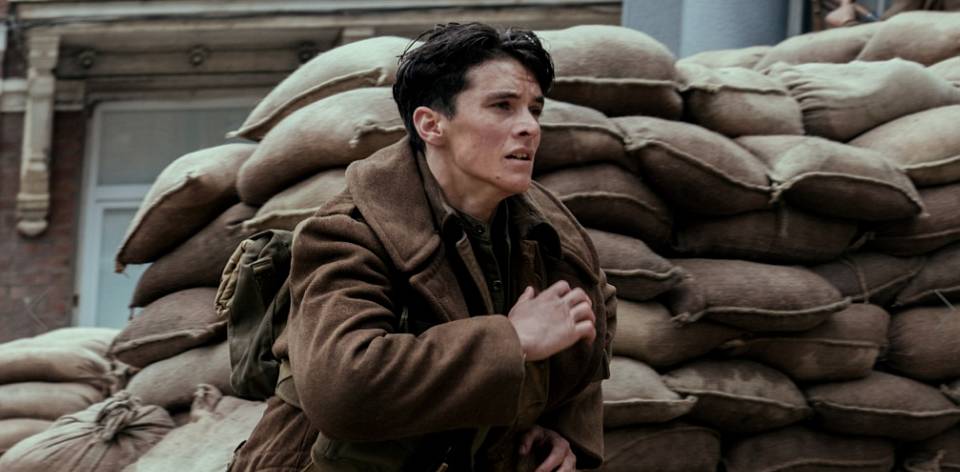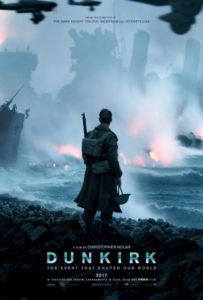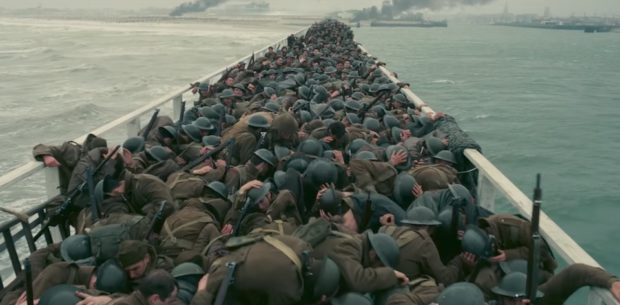Christopher Nolan signals his stylistic intent from the opening frames of DUNKIRK, an eerily still series of images of a soldier running through empty streets, immediately shattered by gunfire. We discover he is a microcosm of the whole, with hundreds of thousands of British troops lining the beaches, fired upon as they wait for the slim chance of escape. Which is what he wants to tell us about the historic evacuation, a quintessentially British tale of survival and stiff upper lipness.
Structured around three intersecting narratives, each beginning at a different point in time, Nolan’s vision of Operation Dynamo is laser focused. The Germans are an abstract, represented only by the silence-splitting planes of the Luftwaffe dropping their bombs. On the beachfront mole, British private Tommy (Fionn Whitehead) struggles to reach the boats in time. In the skies, Collins (Jack Lowden) and Farrier (Tom Hardy) fend off enemy targets. Meanwhile, civilian mariner Dawson (Mark Rylance) and his sons head towards the battle to rescue whoever they can, including a shivering soldier (Cillian Murphy) they find in the ocean.
Earlier this year, Lone Scherfig’s comedy-drama Their Finest explored the production of a British propaganda film about the ‘Dunkirk Miracle.’ While it is easy to imagine that DUNKIRK is the 21st century equivalent of that production, Nolan’s film is a far gloomier prospect that anything crafted to boost morale on the homefront. “All we did is survive,” laments one of the evacuees in the film’s final act, and Nolan’s narrative is both a testament to that will to (keep calm and) carry on and the futility of the war that surrounded it.
Nolan’s singular vision is one that comes with his trademark nonlinear version of time, coalescing in a glorious mixture of sound and fury that doesn’t so much recreate battle as the feeling of it. It’s like Terence Malick’s impressionistic The Thin Red Line, but condensed to a gut-punch size and underscored by composer Hans Zimmer’s staccato of building tension. That score is admittedly overbearing at times, dominating all the senses at once. Yet as the relentless second hand of a watch ticks its way through a ubiquitous drone, it’s hard to deny that it impacts the viewer physically.
In the midst of this cacophony of audiovisual noise, one that is crisply shot in the sweeping 70mm IMAX that fills in the remaining gaps of the atmosphere, individual performances are subservient to the whole. The story threads are not built around those characters, they are merely representatives of key elements of the overall effort. Kenneth Branagh’s Commander Bolton is all of the officer class, while Whitehead is all soldiers. The highly-touted appearance of Harry Styles is perfectly fitting with the pin-up soldier trope for the folks back home. Rylance and his boys are that home, something Nolan acknowledges in a rare indulgent piece of patriotic dialogue.
The word ‘masterpiece’ is bandied around a lot, but DUNKIRK comes close to being Nolan’s finest work. Leaving us on an somewhat foreboding dour note, he offers us no easy answers or judgments, instead dropping us in the midst of war and allowing the immersive experience to guide our observations.






